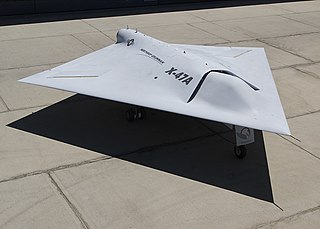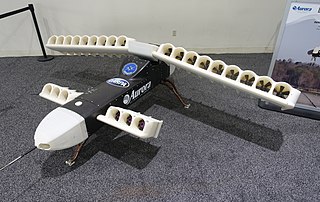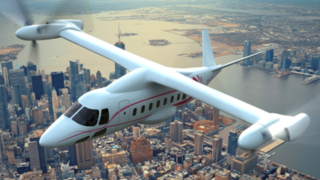
A tiltrotor is an aircraft that generates lift and propulsion by way of one or more powered rotors mounted on rotating shafts or nacelles usually at the ends of a fixed wing. Almost all tiltrotors use a transverse rotor design, with a few exceptions that use other multirotor layouts.

The Northrop Grumman X-47 is a demonstration unmanned combat aerial vehicle. The X-47 began as part of DARPA's J-UCAS program, and is now part of the United States Navy's UCAS-D program to create a carrier-based unmanned aircraft. Unlike the Boeing X-45, initial Pegasus development was company-funded. The original vehicle carries the designation X-47A Pegasus, while the follow-on naval version is designated X-47B.

The Sikorsky Cypher and Cypher II are types of unmanned aerial vehicles developed by Sikorsky Aircraft. They are vertical takeoff and landing aircraft which use two opposing rotors enclosed in a circular shroud for propulsion.

The Bell 407 is a four-blade, single-engine, civil utility helicopter. A derivative of the Bell 206L-4 LongRanger, the 407 uses the four-blade, soft-in-plane design rotor with composite hub developed for the United States Army's OH-58D Kiowa Warrior instead of the two-blade, semi-rigid, teetering rotor of the 206L-4.

The Curtiss-Wright X-19, company designation Model 200, was an American experimental tiltrotor aircraft of the early 1960s. It was noteworthy for being the last aircraft of any kind manufactured by Curtiss-Wright.

The Boeing X-50A Dragonfly, formerly known as the Canard Rotor/Wing Demonstrator, was a VTOL rotor wing experimental unmanned aerial vehicle that was developed by Boeing and DARPA to demonstrate the principle that a helicopter's rotor could be stopped in flight and act as a fixed wing, enabling it to transition between fixed-wing and rotary-wing flight.

The Boeing A160 Hummingbird is an unmanned aerial vehicle (UAV) helicopter. Its design incorporates many new technologies never before used in helicopters, allowing for greater endurance and altitude than any helicopter currently in operation.

The Boeing Model 360 is an American experimental medium-lift tandem rotor cargo helicopter developed privately by Boeing to demonstrate advanced helicopter technology. The aircraft was intended as a technology demonstrator, with no plans to put the type into production, and many of its design features were carried onto other programs including the RAH-66 Comanche and V-22 Osprey. The sole prototype has been preserved and is a static exhibit at the American Helicopter Museum in West Chester, Pennsylvania.
The Alenia ITV is a technology demonstrator aircraft developed in Italy in the early 21st century. In the spring of 2003, Alenia Aeronautica of Italy unveiled a non-flying ground-test prototype of a half-scale unmanned combat aerial vehicle demonstrator, known as an "Integration Technology Vehicle (ITV)", with a flight prototype to follow. The ITV has a high-mounted wing with a sweep of 35 degrees; a vee tail; a Microturbo TRI60-5 turbojet, with 4.4 kN thrust, mounted on the back behind the wing; retractable tricycle landing gear; and metal construction.
The Teledyne Ryan BQM-145 Peregrine is a reconnaissance unmanned aerial vehicle (UAV) developed in the United States in the 1990s as a joint U.S. Navy/Marine Corps and Air Force "Medium Range UAV" program, with the Navy developing the airframe and the Air Force providing the payload. The BQM-145A was designed to precede airstrike packages into a target area and relay reconnaissance information in real time.

The Baldwin Mono Tiltrotor project is a research effort into a tiltrotor aircraft that uses only one rotor. Like other tiltrotor configurations, the mono tiltrotor combines the vertical lift capability and structural efficiency of a helicopter with the speed and range of a fixed-wing aircraft.

Aurora Flight Sciences is an American aviation and aeronautics research subsidiary of Boeing which primarily specializes in the design and construction of special-purpose Unmanned aerial vehicles. Aurora has been established for 20+ years and their headquarters is at the Manassas Regional Airport in Manassas, Virginia.

The AeroVironment T-20 unmanned aerial vehicle (UAV) is a medium range, composite aircraft capable of internal and external payloads. Launched from a portable catapult, it can be recovered with a shipboard landing system, or belly land on unimproved surfaces. The T-20 carries a retractable gimbal-mounted, digitally stabilized, electro-optical/infrared (EO/IR) camera that relays video in real time via a C-band LOS data link to the ground control station (GCS). Powered by a 4-stroke, fuel injected gasoline engine, the aircraft burns 2 lb (910 g) of fuel per hour at cruise. AeroVironment, Inc. acquired Arcturus UAV, the original developer of JUMP 20 and T-20 on February 22, 2021.

The Aerial Reconfigurable Embedded System (ARES) was a concept for an unmanned VTOL flight module that can transport various payloads. The concept started as the TX (Transformer) in 2009 for a terrain-independent transportation system centered on a ground vehicle that could be configured into a VTOL air vehicle and carry four troops. ARES' primary function was the same as TX, to use flight to avoid ground-based transportation threats like ambushes and IEDs for units that don't have helicopters for those missions. It was to be powered by twin tilting ducted fans and have its own power system, fuel, digital flight controls, and remote command-and-control interfaces. The flight module would have different detachable mission modules for specific purposes including cargo delivery, CASEVAC, and ISR. Up to 3,000 lb (1,400 kg) of payload would be carried by a module.

The Bell V-280 Valor is a tiltrotor aircraft being developed by Bell Helicopter for the United States Army's Future Vertical Lift (FVL) program. The aircraft was officially unveiled at the 2013 Army Aviation Association of America's (AAAA) Annual Professional Forum and Exposition in Fort Worth, Texas. The V-280 made its first flight on 18 December 2017 in Amarillo, Texas.

The Vertical Take-Off and Landing Experimental Aircraft program is an American research project sponsored by the Defense Advanced Research Projects Agency (DARPA). The goal of the program is to demonstrate a VTOL aircraft design that can take off vertically and efficiently hover, while flying faster than conventional rotorcraft. There have been many previous attempts, most of them unsuccessful.

The Tactical Robotics Cormorant, formerly AirMule or Mule, Israel Defense Forces (IDF) codename Pereira, is a flying car unmanned aerial vehicle (UAV) built by Tactical Robotics Ltd., a subsidiary of designer Rafi Yoeli's Urban Aeronautics Ltd., in Yavne, Israel. It will be used in search and rescue operations where it is too dangerous or inaccessible for a helicopter, such as evacuating people from the upper stories of burning buildings, or delivering and extracting police and soldiers while very close to structures, narrow streets, or through holes into confined spaces.

The Bell V-247 Vigilant is a concept by Bell Helicopter to develop a large tiltrotor unmanned aerial vehicle.

The Aurora XV-24 LightningStrike is an experimental unmanned aerial vehicle created by Aurora Flight Sciences and partners Rolls-Royce and Honeywell. It was developed for the Vertical Take-Off and Landing Experimental Aircraft program.

The Leonardo Next-Generation Civil Tiltrotor is a tiltrotor aircraft demonstrator designed and developed by the Italian aerospace company Leonardo S.p.A. Studies for a two times larger tiltrotor than the AgustaWestland AW609 started in 2000. Since 2014, its development is sponsored by the European Union's Clean Sky 2 program. By May 2021, major components were under production By 2023, the maiden flight had been pushed back to 2024, from a 2020 initial plan.

















